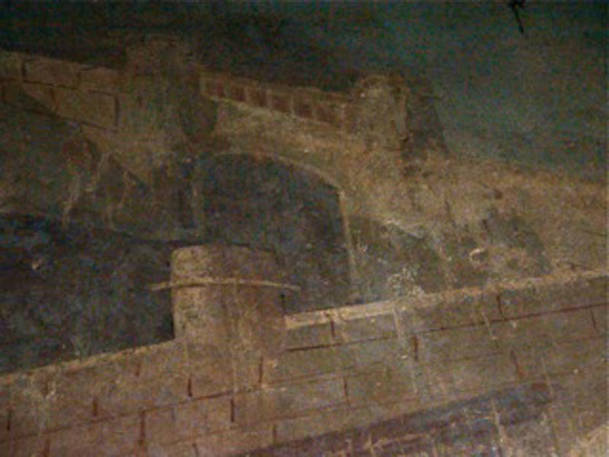


ROME – For over fifteen years Piero Giusberti, an architect specialized in archaeological restorations, has been digging in Roman dirt—ancient Roman dirt, that is. And in what amounts to a sneak preview for i-italy, last week he showed this reporter through the so-called Cryptoporticus, an amazing, high-ceilinged underground gallery on the Oppian Hill to see the latest discovery: a First Century AD colorful wall mosaic, 53 feet long and 6.6 feet high, whose centerpiece is a nude Apollo, god of poetry and music, flanked by the Muses. Border details show a sophisticated use of perspective.
The gallery stands atop a corner of the ruins of Nero’s Domus Aurea, the Golden House overlooking the artificial lake where the Colosseum was subsequently built. Its famous portico was the showcase for the emperor’s collection of 100 or so statues, but after Nero’s forced suicide in 68 AD, the whole Domus Aurea complex was destroyed in the Romans’ campaign of dannatio memoriae, intended to erase all memory of him.
Today, with countless tons of earth removed, the gallery has been cleared enough to show that it culminates in an elegantly decorated room which may have served as a lobby for a municipal office building dating from the time of the Emperor Titus (AD 79-81), who finished the Colosseum and built modest baths atop the hilly site.
In turn, two decades later the Baths of Titus were knocked down and replaced by the emperor Trajan’s far more ambitious and sprawling complex of thermal baths, probably on designs by the visionary Greek architect Apollodorus of Damascus, author of Trajan’s Market and, it is believed, of the Pantheon. The gallery with the mosaic remained as part of the foundations for Trajan’s Baths.
Dedicated in 109 AD, they were in use for perhaps four centuries, but fell into neglect after the Goths besieged Rome in 537. From that point on the tunnel-like gallery below remained untouched for centuries, although during the Renaissance, scavengers hunting buried treasure dug pits that were later used as dumps. In addition, prior to the Napoleonic conquest of Italy in the early 19th Century, the Vatican army protecting the pope used the gallery as a powder magazine. Indeed, Giusberti and his team have uncovered a series of vats which once held potassium nitrate, the chemical compound used in gunpowder. Fortunately, unlike the Acropolis in Athens, which was similarly used as a munitions depot, this did not explode.
Work to unearth the gallery began in the early 1990s under the Rome city archaeological division, then headed by Eugenio La Rocca. “When we began,” Giusberti relates, “the lower half was entirely filled with earth, and the Colle Oppio gardeners used it to store their equipment. No one imagined what lay below.”
Because Rome has never been abandoned, non-monumental ruins revealing the details of daily life, such as an office waiting room, are found rarely, and Giusberti’s work has brought us a postcard from ancient Rome at the height of empire. The decorated gallery is an exceptional find, as is the painted wall in the big room which shows what La Rocca called a “bird’s eye view” of a particularly prosperous Roman city.
“We don’t yet know which city. Perhaps it is imaginary, but it must resemble Rome itself,” said Giusberti, pointing to walls painted to look like stone surrounding the town. “Inside the walls we have a temple, a theater, and people’s homes jammed close together.”
Thirteen years ago a first portion of this painted wall was discovered, showing boats in a river port giving onto the sea and a bridge with constructions atop, like the gallery over Florence’s Ponte Vecchio. Countless conjectures were made about which town was depicted, but to date without success. Peering through a miniature video camera, one could also see into an adjacent room, where a mosaic wall shows a lively scene of a grape harvest, with men picking bunches of grapes while others, barefoot, trampled grapes in a big vat. I saw it at that time, at eye level; earth clearance today puts it high above the present (and still temporary) ground level, so that I have to tilt my head back to see it. This adjacent room is as yet unexcavated, but will be in the near future, Giusberti promises.
Restoration of the gallery has been complex and expensive since, besides the extensive earth removal, consolidation of its perimeter was required, and waterproofing of the Trajan-level vault. But the rewards continue as earth removal deepens the floor level. A hint of what is to come: what seemed a pit proved to be a perpendicular tunnel leading down into an early Nymphaeum, or wall fountain area dedicated to the Nymphs.
Source URL: http://test.casaitaliananyu.org/magazine/focus/art-culture/article/getting-dirt-ancient-rome
Links
[1] http://test.casaitaliananyu.org/files/colle-oppio-bridge-ptg-20111313432802jpeg